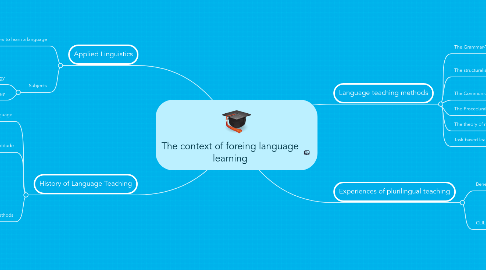The context of foreing language learning
Ana Maria Fortes Barralにより


1. Applied Linguistics
1.1. Factors to learn a language
1.1.1. Age
1.1.2. Attitude
1.1.3. Output
1.1.4. Input
1.2. Subjects
1.2.1. Psichology
1.2.2. Pedagogy
2. History of Language Teaching
2.1. Purposes to learn a language
2.2. Language Aptitude
2.2.1. Auditory Ability
2.2.2. Memory Ability
2.2.3. Linguistic Ability
2.3. Different methods
2.3.1. The Direct Method
2.3.2. The Silent Way
2.3.3. Prendergast
2.3.4. The Series Method
2.3.5. The Audiolingual Method
2.3.6. Designer Methods
3. Language teaching methods
3.1. The Grammar-Translation Method
3.2. The structuralist methods
3.2.1. The Oral Approach
3.2.2. The Audiolingual Method
3.3. The Communicative Approach
3.4. The Procedural Approaches
3.5. The theory of multiple intelligences
3.5.1. Brain-based learning
3.6. Task-based learning
4. Experiences of plurilingual teaching
4.1. Benefits
4.1.1. Education
4.1.2. Content
4.1.3. Language
4.1.4. Social
